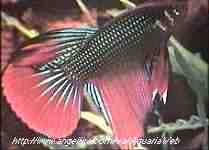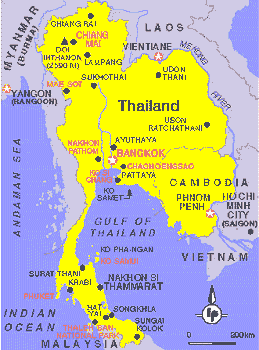

Common Name: Siamese Fighting Fish
Scientific Name: Betta splendens
(REGAN, 1910)
Pronounced: Bet'ta (not bay-ta) splen'dens
Meaning of Name: Betta, after a local native name, Ikan bettah;
splendens, brilliant.
Categories: Genus of the Belontiidae, Sub-order
Anabantoidei, Sub-family Macropodinae.
Origins: Southeast Asia; Thailand and Cambodia; (Siam). Rice fields
and slow moving streams.

Description: In the wild it can grow up to 2 inches (5cm), otherwise
up to 2.6 inches (6.5 cm). The body is elongated with the dorsal fin
far back and very broad, while the caudal fin is rounded. The ventral fins
are saber shaped. Varied in colors, red, blue, green, black, and multi-colored.
Mostly a brown with a blue green glowing, but may appear red or blue when
excited. Body has metallic, usually green dots, often in rows. The female
is brownish with faint crossing bars, and is easily recognized by the shorter
fins.
The males are particularly aggressive and should never be kept together.
They even will show their aggressiveness to a reflection of themselves in
a mirror, "flaring" their fins erect and spreading their gill covers. The
males have been used like fighting cocks in Thailand for several hundred
years in contests.
The Betta is a labyrinth fish (having an auxiliary breathing apparatus
known as the labyrinth organ), enabling it to breath air from the surface,
and to tolerate water with little dissolved oxygen. They are a short
lived fish. At a year, they are at their prime.
Diet: Worms, crustaceans, insects, dried food, frozen and live
foods.
Environment: The composition of the water is not important, 77 to
83F (25 to 28C). It can survive in temperatures between 68 and 90F, but thrives
best at about 79-80F.
Tank Mates: Female Betta splendens, Black Molly, Chinese algae
eaters, (gentle) Tetras, and catfish. Never another male betta, they
should be reared individually. What do you have?
Breeding: Breeding is not very difficult. Have
the water level no more than 6 inches in depth in a tank of at least 10 gallons.
Heat with a submersible heater, or place the heater in a tall jar of water,
and place it in the shallow water. The temperature should be kept close to
80F. Keep the bottom of the tank bare (easier to clean), however a few floating
plants are an advantage. Don't use an airstone or filter, this will break
up the bubblenest.
Place the male into the tank, and the female in a small jar floating
where the male can see her. They will gradually get acquainted and after
a few hours let the female out. The courting tends to get rough, and if the
female starts to get damaged, i.e. nipped fins, remove her for her own
safety. Wait awhile and then start over. If available you might want to try
a different female. The male will then begin to build a bubblenest floating
at the surface from a sticky mucous secretion. The nest can be several inches
across and three or four bubbles deep. I have had them in a divided 10 gallon
tank where the bubblenest completely filled the males half! The male will
chase the female away while building the nest, but when he is finished he
will try to coax her beneath it.
Following a fascinating courtship ritual, the male will use his mouth
to retrieve the eggs that were released by the female. He then carries them
to the nest and places them in it. The spawning will continue until the female
is empty of eggs (between 150 and 500). This is the time the female should
be removed completely from the tank and given some tender care.The male will
immediately begin repairs on the nest, watch for and replace falling eggs,
and guard the nest against intruders (including the female). If the water
is kept at 80F, the eggs should begin to hatch in 24 to 30 hours. After 2
or 3 days, the yolk sacs will be absorbed and the fry will become free-swimming.
The male will become nervous, and it is best to remove him from the tank
at this time.
The fry can be fed at first on a supply of infusorians and rotifers.
If infusoria is not available, finely crushed dried foods can be used as
a substitute. Also, the yolk of a hard boiled egg squeezed through a cloth
beneath the water surface can be used. After the fry have grown some (5-6
days), they can be fed newly hatched brine shrimp
(Artemia) or Cyclops larvae.